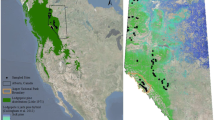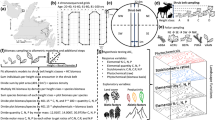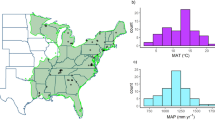Abstract
Lodgepole pines, Pinus contorta Douglas ex Louden var. latifolia Engelm. ex S. Watson, are encountering increased abiotic stress and pest activity due to recent increases in temperature and changes in precipitation throughout their range. This tree species counters these threats by producing secondary metabolites, including phenolics and terpenoids. We examined foliar levels of lignin, soluble phenolics, monoterpenoids, sesquiterpenoids, and diterpenoids in 12 stands in British Columbia, Canada. We used these data to assess associations among foliar secondary metabolite levels and ecosystem, geographic, and climatic variables. Regressions were also performed to observe which combinations of variables best explained secondary metabolite variance. Stands of P. c. latifolia in the Coastal Western Hemlock and Interior Cedar/Hemlock biogeoclimatic zones had consistently greater foliar levels of almost all measured secondary metabolites than did other stands. Lignin was present in greater amounts in Boreal White/Black Spruce ecosystem (i.e., northern) stands than in southern stands, suggesting a role for this metabolite in pine survival in the boreal forest. Attempts to develop regression models with geographic and climatic variables to explain foliar secondary metabolite levels resulted in multiple models with similar predictive capability. Since foliar secondary metabolite levels appeared to vary most between stand ecosystem types and not as much due to geographic and climatic variables, metabolic profiles appeared best matched to the stress levels within local environments. It is unknown if differences in secondary metabolite levels are the result of genetic adaptation or phenotypic plasticity, but results from this and other studies suggest that both are important. These results are interpreted in light of ongoing efforts to assist in the migration of certain populations of P. c. latifolia northward in an effort to counter predicted effects of climate change.


Similar content being viewed by others
References
Adams, J. M., Rehill, B., Zhang, Y., and Gower, J. 2009. A test of the latitudinal defense hypothesis: herbivory, tannins and total phenolics in four North American tree species. Ecol. Res. 24:697–704.
Akaike, H. 1974. A new look at the statistical model identification. IEEE Trans. Automat. Contr. 19:716–723.
Allen, E., Morrison, D., and Wallis, G. 1996. Common Tree Diseases of British Columbia. Canadian Forest Service-Pacific Forestry Centre: Victoria, BC, Canada, pp 178.
Andrew, N. R. and Hughes, L. 2005. Herbivore damage along a latitudinal gradient: relative impacts of different feeding guilds. Oikos 108:176–182.
Bentz, B. J., Régnière, J., Fettig, C .J., Hansen, E. M., Hayes, J. L., Hicke, J. A., Kelsey, R. G., Negrón, J. F., and Seybold, S. J. 2010. Climate change and bark beetles of the western US and Canada: Direct and indirect effects. BioScience 60:602–613.
Burnham, K. P. and Anderson, D. R. 2002. Model Selection and Multi-model Inference: A Practical Information-Theoretic Approach, 2nd ed. Springer-Verlag, New York, NY, USA, pp 488.
Coakley, S. M., Scherm, H., and Chakraborty, S. 1999. Climate change and plant disease management. Annu. Rev. Phytopathol. 37:399–426.
Cumming, S. G. and Burton, P. G. 1996. Phenology-mediated effects of climate change on some simulated British Columbia forests. Clim. Change 34:213–222.
Desprez-Loustau, M. L., Robin, C., Reynaud, G., Deque, M., Badeau, V., Pion, D., Husson, C., and Marcais, B. 2007. Simulating the effects of a climate-change scenario on the geographical range and activity of forest-pathogenic fungi. Can. J. Plant Pathol. 29:101–120.
Folke, C., Carpenter, S., Walker, B., Scheffer, M., Elmqvist, T., Gunderson, L., and Holling, C. S. 2004. Regime shifts, resilience, and biodiversity in ecosystem management. Annul. Rev. Ecol. Evol. Syst. 35:557–581.
Franceschi, V. R., Krokene, P., Christiansen, E., and Krekling, T. 2005. Anatomical and chemical defenses of conifer bark against bark beetles and other pests. New Phytol. 167:353–376.
Hamann, A. and Wang, T. 2006. Potential effects of climate change on ecosystem and tree species distribution in British Columbia. Ecology 87:2773–2786.
Heineman, J., Sachs, D. L., Mather, W. J., and Simard, S. W. 2010. Investigating the influence of climate, site, location, and treatment factors on damage to young lodgepole pine stands in southern British Columbia. Can. J. For. Res. 40:1109–1127.
Hengxiao, G., McMillin, J. D., Wagner, M. R., Zhou, J., Zhou, Z., and Xu, X. 1999. Altitudinal variation in foliar chemistry and anatomy of Yunnan pine, Pinus yunnanensis, and pine sawfly (Hym., Diprionidae) performance. J. Appl. Ent. 123:465–471.
Herms, D. A. and Mattson, W. J. 1992. The dilemma of plants—to grow or defend. Quart. Rev. Biol. 67:283–335.
Hobbs, S. D. and Partridge, A. D. 1979. Wood decays, root rots, and stand composition along an elevation gradient. For. Sci. 25:31–42.
Hodkinson, I. D. 2005. Terrestrial insects along elevation gradients: species and community responses to altitude. Bio. Rev. 80:489–513.
Jaakola, L. and Hohtola, A. 2010. Effect of latitude on flavonoid biosynthesis in plants. Plant Cell Environ. 33:1239–1247.
Keeling, C. I. and Bohlmann, J. 2006. Diterpene resin acids in conifers. Phytochemistry 67:2415–2423.
Koricheva, J., Larsson, S., Haukioja, E., and Keinanen, M. 1998. Regulation of woody plant secondary metabolism by resource availability: hypothesis testing by means of meta-analysis. Oikos 83:212–226.
Kurz, W. A., Dymond, C. C., Stinson, G., Rampley, G. J., Neilson, E. T., Carroll, A. L., Ebata, T., and Safranyik, L. 2008. Mountain pine beetle and forest Carbon feedback to climate change. Nature 452:987–990.
Lätti, A. K., Jaakola, L., Riihinen, K. R., and Kainulainen, P. S. 2008. Anthocyanin and flavonol variation in bog bilberries (Vaccinium uliginosum L.) in Finland. J. Agric. Food Chem. 58:427–433.
Logan, J. A., Régnière, J., and Powell, J. A. 2003. Assessing the impacts of global warming on forest pest dynamics. Front. Ecol. Environ. 1:130–137.
Marris, E. 2009. Planting the forest of the future. Nature 459:906–908.
Martz, F., Peltola, R., Fontanay, S., Duval, R. E., Julkunen-Tiitto, R., and Stark, S. 2009. Effect of latitude and altitude on the terpenoid and soluble phenolic composition of juniper (Juniperus communis) needles and evaluation of their antibacterial activity in the boreal zone. J. Agri. Food Chem. 57:9575–9584.
Martz, F., Jaakola, L., Julkunen-Tiitto, R., and Stark, S. 2010. Phenolic composition and antioxidant capacity of bilberry (Vaccinium myrtillus) leaves in northern Europe following foliar development and along environmental gradients. J. Chem. Ecol. doi 10.1007/s10886-010-9836-9
Meidinger, D. and Pojar, J. 1991. Ecosystems of British Columbia. BC Min. For., Res. Br. Victoria, BC, pp 330.
O’Neill, G. A., Hamann, A., and Wang, T. 2008. Accounting for population variation improves estimates of the impact of climate change on species’ growth and distribution. J. Applied Ecol. 45:1040–1049.
Rehfeldt, G. E., Ying, C. C., Spittlehouse, D. L., and Hamilton, D. A. 1999. Genetic responses to climate in Pinus contorta: Niche breadth, climate change, and reforestation. Ecol. Monogr. 69:375–407.
Schwarz, G. E. 1978. Estimating the dimension of a model. Ann. Stat. 6:461–464.
Seybold, S. J., Huber, D. P. W., Lee, J. C., Graves, A. D., and Bohlmann, J. 2006. Pine monoterpenes and pine bark beetles: A marriage of convenience for defense and chemical communication. Phytochem. Rev. 5:143–178.
Siska, E. L., Pennings, S. C., Buck, T. L., and Hanisak, M. D. 2002. Latitudinal variation in palatability of salt-marsh plants: which traits are responsible. Ecology 83:3369–3381.
Smallwood, M. and Bowles, D. 2002. Plants in a cold climate. Phil. Trans. R. Soc. Lond. B 357:831–847.
Stark, S., Julkunen-Tiitto, R., Holappa, E., Mikkola, K., and Nikula, A. 2008. Concentrations of foliar quercetin in natural populations of white birch (Betula pubescens) increase with latitude. J. Chem. Ecol. 34:1382–1391.
Wallis, C., Eyles, A., Chorbadjian, R., McSpadden Gardener, B., Hansen, R., Cipollini, D., Herms, D. A., and Bonello, P. 2008. Systemic induction of phloem secondary metabolism and its relationship to resistance to a canker pathogen in Austrian pine. New Phytol. 177:767–778.
Wallis, C. M., Reich, R., Lewis, K. J., and Huber, D. P. W. 2010. Lodgepole pine provenances differ in chemical defense capacities against foliage and stem diseases. Can. J For. Res. 40:2333–2344.
Walther, G. R., Post, E., Convey, P., Menzel, A., Parmesan, C., Beebee, T. J. C., Fromentin, J.-M., Hoegh-Guldberg, O., and Bairlein, F. 2002. Ecological responses to recent climate change. Nature 416:389–395.
Wang, T., Hamann, A., Spittlehouse, D., and Aitken, S. N. 2006. Development of scale-free climate data for western Canada for use in resource management. Int. J. Climatol. 26:383–397.
Wei, H., Dhanaraj, A. L., Arora, R., Rowland, L. J., Fu, Y., and Sun, L. 2006. Identification of cold acclimation-responsive Rhododendron gene for lipid metabolism, membrane transport and lignin biosynthesis: importance of moderately abundant ESTs in genomic studies. Plant Cell Env. 29:558–570.
Welsh, C., Lewis, K., and Woods, A. 2009. The outbreak history of Dothistroma needle blight: an emerging forest disease in northwestern British Columbia, Canada. Can. J. For. Res. 39:2505–2519.
Whitzell, J. and Martin, J. A. 2008. Phenolic metabolites in the resistance of northern forest trees to pathogens—past experiences and future prospects. Can. J. For. Res. 38:2711–2727.
Woods, A., Coates, K. D., and Hamann, A. 2005. Is an unprecedented Dothistroma needle blight epidemic related to climate change? Bioscience 55:761–769.
Wu, H. X., Ying, C. C., and Muir, J. A. 1996. Effect of geographic variation and jack pine introgression on disease and insect resistance in lodgepole pine. Can. J. For. Res. 26:711–726.
Wu, H. X., Ying, C. C., and Ju, H. B. 2005. Predicting site productivity and pest hazard in lodgepole pine using biogeoclimatic system and geographic variables in British Columbia. Ann. For. Sci. 62:31–42.
Ying, C. C. and Yanchuk, A. D. 2006. The development of British Columbia’s tree seed transfer guidelines: purpose, concept, methodology, and implementation. For. Ecol. Manage. 227:1–13.
Acknowledgments
The authors thank Nick Ukraintz, Alex Woods, Brian Aukema, Sam Barnes, and Rhiannon Montgomery for planning and technical help in executing this study. We also acknowledge the University of Northern British Columbia, the Forest Genetic Council of British Columbia, the British Columbia Ministry of Forests and Range, the Natural Science and Engineering Research Council of Canada, the Canada Research Chairs Program, the Canada Foundation for Innovation, and the British Columbia Knowledge Development Fund for funding and other support in conducting this research.
Author information
Authors and Affiliations
Corresponding author
Additional information
USDA is an equal opportunity provider and employer.
Rights and permissions
About this article
Cite this article
Wallis, C.M., Huber, D.P.W. & Lewis, K.J. Ecosystem, Location, and Climate Effects on Foliar Secondary Metabolites of Lodgepole Pine Populations from Central British Columbia. J Chem Ecol 37, 607–621 (2011). https://doi.org/10.1007/s10886-011-9958-8
Received:
Revised:
Accepted:
Published:
Issue Date:
DOI: https://doi.org/10.1007/s10886-011-9958-8




